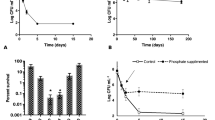Abstract
The effect of NaCl concentration gradients on the growth of a marine species,Vibrio pelagius, and two freshwater and estuarine species,Vibrio cholerae andAeromonas hydrophila, was determined in chemostat cultures containing a mineral medium withd-glucose as the sole source of carbon and energy. Complementary cell density profiles were obtained with the marine and the freshwater-estuarine species at the extreme ends of the NaCl concentration gradients. At the lower NaCl concentrations,V. cholerae andA. hydrophila attained maximal cell densities, while no growth or submaximal cell yields were characteristic ofV. pelagius; the reverse was true at the higher NaCl concentrations. At the intermediate concentrations (100–400 mM) all three organisms were able to grow with cell densities ranging from 80%–100% of the maximum. Competition experiments betweenV. cholerae andV. pelagius within this region (100, 150, and 300 mM) indicated that the lower NaCl concentrations favoredV. cholerae while the higher concentrations favoredV. pelagius. The results suggest that the responses ofV. pelagius, V. cholerae, andA. hydrophila to different concentrations of NaCl are important in determining the environmental distribution of these species.
Similar content being viewed by others
Literature Cited
Baumann, P., Baumann, L. 1981. The marine gram-negative eubacteria, pp. 1302–1331. In: Starr, M. P., Stolp, H., Trüper, H. G., Balows, A., Schlegel, H. G. (eds.) The prokaryotes, ch. 104. New York: Springer-Verlag.
Baumann, P., Baumann, L., Hall, B. G. 1981. Lactose utilization byVibrio vulnificus. Current Microbiology6:131–135.
Baumann, P., Baumann, L., Woolkalis, M. J., Bang, S. S. 1983. Evolutionary relationships inVibrio andPhotobacterium: a basis for a natural classification. Annual Review of Microbiology37:369–398.
Baumann, P., Furniss, A. L., Lee, J. V. 1984. GenusVibrio. pp. 5518–5538. In: Krieg, N. R. (ed.), Bergey's manual of systematic bacteriology, vol. 1. Baltimore: Williams and Wilkins.
Crawford I. P. 1954. A new fermentative pseudomonad,Pseudomonas formicans, n. sp. Journal of Bacteriology68:734–738.
Desmarchelier, P. M., Reichelt, J. L. 1982. Genetic relationships among clinical and environmental isolates ofVibrio cholerae from Australia. Current Microbiology7:53–57.
Gow, J. A., MacLeod, R. A., Goodbody, M., Frank, D., De Voe, L. 1981. Growth characteristics at low Na+ concentration and stability of the Na+ requirement of a marine bacterium. Canadian Journal of Microbiology27:350–357.
Holmes, R. K. Vasil, M. L., Finkelstein, R. A. 1975. Studies of toxinogenesis inVibrio cholerae. III. Characterization of nontoxinogenic mutants in vitro and in experimental animals. Journal of Clinical Investigation55:551–560.
Jannasch, H. W. 1969. Estimations of bacterial growth rates in natural waters. Journal of Bacteriology99:156–160.
Jannasch, H. W., Mateles, R. I. 1974. Experimental bacterial ecology studies in continuous cultures. Advances in Microbial Physiology11:165–212.
Kaper, J., Lockman, H., Colwell, R. R., Joseph, S. W. 1979. Ecology, serology and enterotoxin production ofVibrio cholerae in Chesapeake Bay. Applied and Environmental Microbiology37:91–103.
Kaper, J. B., Lockman, H., Colwell, R. R., Joseph, S. W. 1981.Aeromonas hydrophila: ecology and toxigenicity of isolates from an estuary. Journal of Applied Bacteriology50:359–377.
Lewin, B. 1977. Gene expression-3. New York: Wiley.
MacLeod R. A. 1965. The question of the existence of specific marine bacteria. Bacteriological Reviews29:9–23.
MacLeod, R. A. 1968. On the role of inorganic ions in the physiology of marine bacteria. Advances in Microbiology of the Sea1:95–126.
MacLeod R. A. 1980. Observations on the role of inorganic ions in the physiology of marine bacteria, pp. 5–29. In: Morishita, H., Masui M. (eds.) Saline environment. Osaka: Organizing Committee of Japanese Conference on Halophilic Microbiology.
MacLeod, R. A., Onofrey, E. 1963. Studies on the stability of the Na+ requirement of marine bacteria, pp. 481–489. In: Oppenheimer, C. H. (ed.), Symposium on marine microbiology. Springfield, IL: Charles C. Thomas.
Popoff, M. 1984. GenusAeromonas pp. 545–548. In: Krieg, N. R. (ed.), Bergey's manual of systematic bacteriology, vol 1, Baltimore: Williams and Wilkins.
Reichelt, J. L., Baumann, P. 1974. Effect of sodium chloride on growth of heterotrophic marine bacteria. Archives of Microbiology97:329–345.
Rodriguez-Valera, F., Ruiz-Berraquero, F., Ramos-Cormenzana, A. 1980. Behaviour of mixed populations of halophilic bacteria in continuous cultures. Canadian Journal of Microbiology26:1259–1263.
Smith, D. W., Finazzo, S. F. 1981. Salinity requirements of a marineThiobacillus intermedius. Archives of Microbiology129:199–203.
Tempest, D. W. 1970. The continuous cultivation of microorganisms. I. Theory of the chemostat, pp. 259–276. In: Norris, J. R., Ribbon, D. W. eds.), Methods in microbiology, vol 2. New York: Academic Press.
Yanagita, T., Takagi, M. 1980. Model experiments on the growth of enteric bacteria in fresh and sea water. Journal of General and Applied Microbiology26:299–305.
Author information
Authors and Affiliations
Rights and permissions
About this article
Cite this article
Bowditch, R.D., Baumann, P. NaCl concentration determines the outcome of competition experiments betweenVibrio pelagius andVibrio cholerae in chemostat cultures. Current Microbiology 11, 221–225 (1984). https://doi.org/10.1007/BF01567164
Issue Date:
DOI: https://doi.org/10.1007/BF01567164




